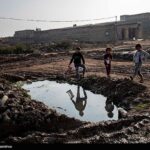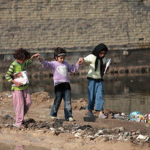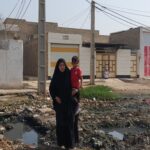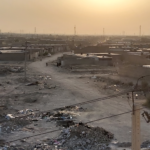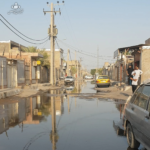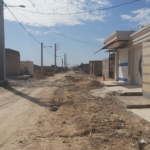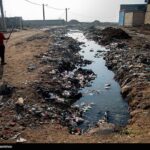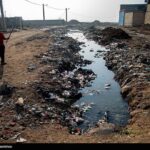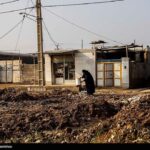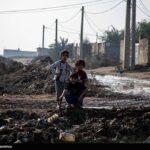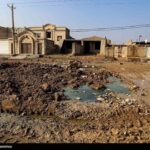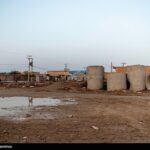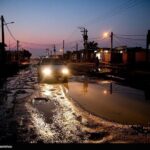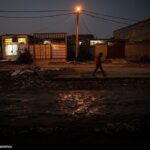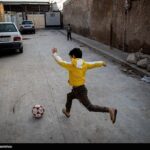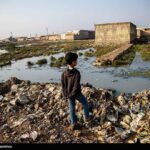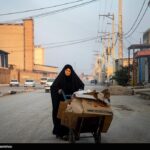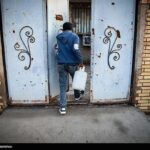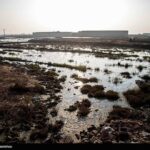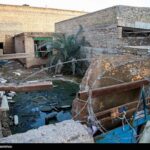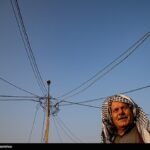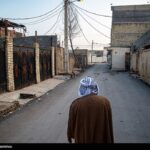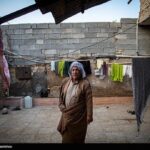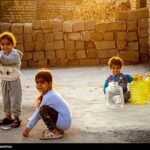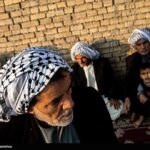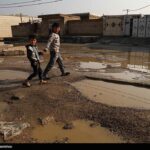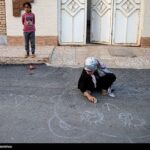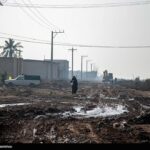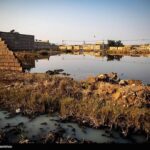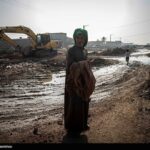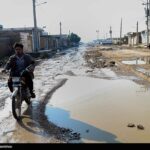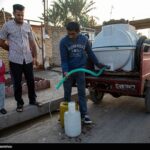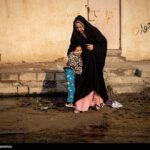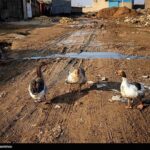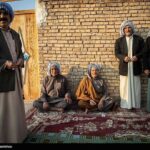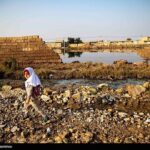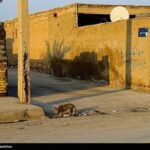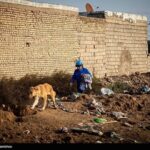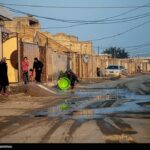Introduction
Access to clean, affordable, and safe drinking water is a fundamental human right recognised by the United Nations and is Goal Number 6 of the United Nation’s Sustainable Development Goals. In Iran, however, access to this essential resource for residents of the Ahwaz region, home to eight million Ahwazi Arab people, is not yet a given, with the majority of Ahwazi areas, both urban and rural, facing water scarcity and approximately 200 areas in the Ahwazi Arab region completely lacking any access to drinking water, with access to water remaining a pervasive development issue across the Ahwaz region for years.
Water resources are essential to maintain all terrestrial life, central to biodiversity, and to maintaining ecosystems, and play a fundamental role in determining every aspect of human life, history, culture, and society, whether agricultural or industrial, being key in determining economic factors – without water, society and thus the economy grind to a halt. In most countries, water resources are valued and carefully managed to ensure the prosperity of agriculture, rural development, industry and energy. The water resources in the Ahwaz region, however, are subjected by the Iranian regime to systematic and environmentally ruinous policies, which changed their course via river-damming and diversion projects to redirect them towards Persian cities; these policies have led to ecological and societal catastrophe in Ahwaz, drying out agricultural lands, causing widespread pollution and worsening the already severe impoverishment of the Ahwazi people.
While the Ahwaz region contains more than 40% of Iran’s water resources, millions of Ahwazis are deprived of any share of their most precious natural resource wealth due to the Iranian regime redirecting most of the water from the region’s rivers to other areas of Iran and refusing to provide safe drinking water to the Ahwazi population. Such policies also make the regime complicit in exacerbating the existing poverty, deprivation, unemployment, and marginalisation, contributing to large-scale migration among Ahwazis by destroying the agricultural sector, which most Ahwazi Arab people are dependent on. According to the Iranian regime’s own reports, 1.2 million people in Ahwaz are economically dependent on agriculture for their income.
This report documents how the Iranian regime deprives the Ahwazis of clean water, the basic urban infrastructure, and other services in Ahwaz and the resulting grave implications for the local Ahwazi residents. Successive Iranian governments have deprived Ahwazi people of clean water for drinking and household use through various strategies, including the construction of dams, cultivating sugar cane, and drilling for oil and gas, amongst others. The report indicates that these policies are reliant on perpetrating crimes against the Ahwazi people that have adversely impacted almost all aspects of life in Ahwaz, prompting analysts and activists to rightfully identify this as an ‘environmental genocide’ or ecocide. In this part, we will discuss the suffering and deprivation of the Ahwazi people in the Malashiyeh district in the city of Ahwaz, the centre of the region.
Drinkable water supplies fit for household use have long been partially or completely absent for residents of the Malashiyeh area, located in the heart of Ahwaz’s eponymous capital city. These water cuts last for days at a time amid summer temperatures that rarely fall beneath 100o Celsius, amid a total ban on media coverage by Iranian media outlets in the region. News of this painful suffering only broke when Ahwazi activists in these regions made it public. Like many others from Ahwaz, whose main area of specialisation is not media-related issues, this activist was moved by the tragedy and decided to raise the subject of this suffering before the public.
It is important to note that the drinking water supply in the poverty-stricken Malashiyeh has never been constant, with water available from faucets for only a few hours per day and often being turned off for several days in a row, as has been the situation in this impoverished neighbourhood in recent days. This is taking place as Ahwaz once again experiences searing summer temperatures that regularly hit 50o C. (122o F). The lack of clean water, the unbearable heat, air pollution and the constant power cuts that plague Ahwazi neighbourhoods have already claimed the lives of several Ahwazi men, women and children so far this year, with the most vulnerable – the very old, very young and those patients with grave underlying health issues such as heart problems, asthma, diabetes and lung and pulmonary diseases – being worst affected.
This worsening crisis provides an opportunity for the media to shed light via social media platforms on the ongoing tragedy, with the water shortages merely the tip of a massive iceberg; for the people of Malashiyeh, the tragedies inflicted on this impoverished district are too many to count.
The lack of municipal planning:
The lack of municipal planning, present in all Ahwazi areas, is so startlingly obvious in the Molashiyeh district that its appearance shocks the eye, with dozens of ramshackle homes constructed within a small area in a wholly unplanned way. The region’s absence of architectural planning is mostly due to the fact that obtaining a strip of land for building has been made impossible for Arabs in accordance with the following formula:
The environmentally devastating policies pursued by the Iranian government have destroyed the Ahwazi people’s agriculture and fishing sectors, causing the rural community of farmers, fishermen and villagers to lose their sources of income. Meanwhile, the Iranian government’s policies, including the war against Iraq, the expansion of cities and the regime incentivising Ahwazi people to live there for lack of other options, have all prompted the rural Ahwazi communities to flee from poverty and lack of water to the region’s cities. However, when these displaced Ahwazis are confronted by obstacles such as the soaring prices of desirable properties and land in Ahwaz city and blatant discrimination in favour of Persian settlers, they have no choice but to move further to the capital’s outskirts, buying the cheap land there that other fellow Ahwazis don’t want and thereby building their homes.
Nonetheless, despite the fact that the land in Malashiyeh was granted to the newcomer Ahwazi Arab dwellers by their fellow Ahwazi citizens, the Iranian government and municipal authorities embarked on threatening the Ahwazi dwellers under the pretext of their not possessing building licenses, that should supposedly be granted by the municipal authorities. However, after the Iranian authorities suspected that the neighbourhood’s residents would become resentful of the relentless persecution and rise up against the Iranian regime for stripping them of their homes, they discontinued these threats. Still, the regime devised other means to punish the Ahwazis in the region, including the suspension of services such as water, electricity, sanitation services, etc. The Iranian government left the Ahwazis to live in impoverished conditions, as we will demonstrate here. Moreover, after the Iranian government failed in its objective of driving Ahwazis out, it devised a new tool to extort money from the Ahwazi people in return for the title deeds to their only remaining homes. In regard to the punitive methods used by the Iranian regime against neighbourhoods such as Molashiyeh, we could point to the retaliatory policies that target the most basic essentials of life that should be available in such neighbourhoods. The Iranian government deliberately left Molashiyeh without potable water, a sewage network, planned or paved streets, or a functioning electricity grid, i.e. the basic amenities that should be available to residents of every community in any modern society.
The marginalisation of Ahwazis in Malashiyeh isn’t confined to these issues, however, with the neighbourhood also lacking any hospital or a small dispensary as well as other services and amenities such as the public transportation, schools, libraries, parks, cinemas and other public facilities. These institutions fall within the second category within the most basic necessities of modern life, even in the 20th century, let alone the 21st.
The lack of potable water
Perhaps this tragedy is what prompted us to dedicate this report to the Molashiyeh. This tragedy marks the peak of the Iranian policy in terms of tampering with the health, psychological safety and the very existence of the Ahwazi Arab people. The social media platforms, which have become the voice of those disadvantaged, are replete with such examples, particularly with reports of the dire effects of the power shortage hitting the region over the past two weeks. What’s important in this case isn’t the water shortage per se, which could occur anywhere in Iran as a result of the public infrastructure glitches. Two issues are particularly important: the constant water cutoff indicated earlier and allowing polluted water to be supplied to the neighbourhood. These severe water shortages and reliance on unsafe supplies have pushed the Ahwazi residents to revert back to primitive methods of extracting water by drilling wells and digging for groundwater.
These practices are particularly significant in a number of ways, the first of which is the apparently wholly deliberate and officially approved nature of the repeated water outages. Exacerbating this tragedy is that what water is provided for Malashiyeh’s residents is heavily polluted, fetid and unsuitable for animal or human use, let alone for drinking. This has given rise to a phenomenon known as the ‘sale of refined water’, which has seen many of the unemployed people in the neighbourhood make a living from selling purified water from tankers mounted on trolleys behind bicycles. The worsening water pollution in Ahwaz and the potentially lethal effects in the impoverished Ahwazi areas have even prompted some Iranian officials to warn of disastrous consequences, including possible disease epidemics, with the officials warning that the water is unfit for human consumption.
The drainage network
Molashiyeh doesn’t enjoy any modern or sophisticated drainage networks. Rather, water is discharged according to old and traditional means via small tributaries where water is stored until being released due to the quantity building up. These uncovered channels are always filled with garbage, blocking them and stopping the water running away. As a result, these uncovered channels regularly overflow, submerging the Malashiyeh in foul effluent and causing further damage to the unpaved dirt roads. The situation deteriorates further in both the summer and winter, with winter’s heavy rainfall putting more pressure on the water channels, leading to heavy flooding, while in summer, the water forms haphazard pools with ‘dams’ of garbage, forming fetid, foul-smelling ponds of wastewater.
With no effort by Iranian authorities to repair or replace the outdated, woefully inadequate infrastructure, the drainage network problem in Ahwaz has deteriorated to a miserable state after remaining unresolved for two decades. Tragic accounts of children falling into these fetid channels and sustaining fractures, being left disabled or dying are not unusual. Everyone in Ahwaz has their own accounts of pain and tragedy connected to this problem.
Unpaved and unplanned streets
These drainage channels wouldn’t need to exist if it weren’t for the total lack of planned and paved streets in Malashiyeh, whose thoroughfares appear to be an endless, twisting labyrinth of narrow walkways, with no planning or paving. The city’s streets are filled with obstructions that prevent people from walking, let alone driving cars and other vehicles.
This lack of planning is mainly caused by the way in which this district came to be built, as we indicated earlier. The neighbourhood was first established to accommodate displaced people who fled their villages, farms and rural homes due to man-made floods, poverty, pollution and lack of job opportunities. It also houses those forced to flee the soaring land and property prices in the city, as well as the anti-Arab racism and discrimination from Persian residents.
Thus, Malashiyeh, like similar neighbourhoods in the capital, Ahwaz, and in other cities across the region, represents the peak of the Iranian regime’s colonial policies and vision, which are fundamentally based on refusing to acknowledge Ahwazi Arabs’ status as the region’s main inhabitants and real landowners, instead plundering all their resources and maintaining them in a marginalised impoverished state in their own territories where they bitterly gravitate to ghettoes on the outskirts of their own cities, suffering every form of poverty and persecution.
The terrible condition of Malashiyeh’s streets has other far-reaching repercussions, including preventing ambulances or fire engines from reacting quickly to any emergency. Due to the potholed, uneven, muddy, narrow and fetid nature of the streets, ambulances and fire engines struggle to reach their destination, making it difficult for paramedics to reach people requiring critical medical care quickly, worsening their situations and potentially threatening their lives. If a fire starts in these overcrowded conditions, meanwhile, it will most likely spread to and burn all of the neighbouring properties, with fire engines struggling to get to the location.
Power cuts
Another aspect of the tough living conditions in Malashiyeh is the power cuts, especially in the searing summer heat of Ahwaz. Even Ahwazis in their 20s and 30s know that the temperature in the region has grown more extreme within the past decade. These rising temperatures are primarily the result of successive Iranian regimes tampering with the Ahwazi environment, diverting the rivers that once made it a fertile agricultural region, and plundering its natural resources, turning the regional breadbasket into a barren, increasingly lifeless area suffering from desertification and drought.
After enduring this deliberate ecological vandalism by the Iranian regime and the temperatures rising above 50 degrees, Ahwazis now suffer again as a result of constant power cuts during this searing summer heat, leaving them without air conditioning or any way to cool down from these oven-like conditions. This regularly leads to severe breathing difficulties, particularly among the infirm, the elderly and children. Moreover, the already massively inadequate electricity infrastructure in Malashiyeh is totally ignored by the Ahwaz Electricity Company, which constantly denies that its network is incapable of delivering electricity even while the people suffer daily power cuts and even while the company admits in its own reports that the crumbling electricity infrastructure in Malashiyeh leads to daily power cuts in the neighbourhood.
The lack of public facilities
The lack of potable water or a properly functioning electricity supply in Malashiyeh on a daily basis are reflections of the lack of basic public facilities and infrastructure, which leaves Ahwazi communities, both rural and urban, unable to sustain their lives. In addition to the lack of public facilities, the people of Malashiyeh, as well as other districts, suffer from other shortages that we will summarise here:
The lack of hospitals or dispensaries
Global healthcare standards indicate that at least one hospital bed should be provided for every 200 people in any area. According to conservative estimates, the population of Malashiyeh is at least 50,000, meaning that there should be 250 beds for the area —the capacity of nearly two hospitals or at least one hospital, given the crumbling healthcare system in Iran.
In reality, the population in Malashiyeh numbers over 80,000. This small district doesn’t even have a small dispensary, let alone a large 125-bed hospital equipped with medical staff, equipment, etc. This grim reality forces local people to use the government hospitals in Ahwaz, which are massively oversubscribed, with people also coping with the high cost of treatment. For a full picture, we should mention Khuzestan and Ilam, Ahwaz’s northern regions, which record high rates of all diseases, particularly cancer and lung diseases due to the pollution of the water, air and land caused by the Iran-Iraq war, oil and steel companies’ waste, droughts leading to sandstorms, state sugar refineries’ waste being poured into what remains of the region’s rivers, and so on. While this should mean that the area has numerous hospitals to address all these severe health crises, in reality, the city suffers the highest mortality rates in Iran while having the lowest levels of public services, water desalination facilities and the lowest level of compliance with global standards in this regard.
Public transport
As noted above, reaching Malashiyeh district is difficult for vehicles due to the unpaved and unplanned nature of its layout. Yet, leaving this district to travel to nearby or distant places and travelling to other parts of Ahwaz also involves severe difficulties. Almost all modes of transport are unavailable for Malashiyeh’s residents; the area is not served by public transport buses or by private taxis. Even in the best-case scenario, a passenger arriving there, getting off a bus or out of a taxi far from home, is forced to walk for a considerable distance until reaching their destination. Another reason why drivers of vehicles or buses don’t like to go into the Malashiyeh district is concern for their vehicles, given the narrow, potholed, uneven dirt roads. This also prevents people from travelling to or from other nearby areas in the same city or only a few kilometres away. One of the indications suggesting there’s a deliberate policy to keep the Malashiyeh district in its impoverished state is that the district is located only 10 kilometres from the upscale neighbourhood of Lashkar, a specially constructed and extremely affluent settlement housing Persian migrants brought to the region by the regime to work in gas, oil and other regime institutions in Ahwaz. Despite being near geographically, the two areas are on different planets in every other way; Lashkar’s broad well-designed and paved streets abound with well-equipped hospitals, cinemas, libraries, etc., and the homes are furnished with every modern amenity; there are no power cuts or water shortages for Lashkar’s residents.
Lack of schools and libraries
Not only does Molashiyeh lack modes of transportation, but it is also relegated to second-class status in terms of educational facilities or public libraries. We have pointed to the impact of the unpaved roads and the lack of adequate transportation on public health in the district, given the difficulty of getting those in critical conditions to hospitals. Meanwhile, the lack of public transport prevents students from accessing schools or universities. It’s worth noting that despite all the privations faced by its residents, Malashiyeh has still produced some inspirational sporting figures and scientific luminaries, of whom we might mention Mrs Hashemiyeh Mutaqian, as well as a number of distinguished filmmakers and poets. All those now famous figures have stories to tell about their suffering while growing up and how they strived to overcome the obstacles caused by deprivation and persecution exercised against them and others from their neighbourhood.
Lack of parks, cinemas, recreational and artistic institutions
The grim picture of deprivation afflicting this neighbourhood in the heart of the regional capital, Ahwaz, doesn’t stop at practical matters; as in Ahwaz generally, the people are denied recreational facilities such as parks, cinemas, galleries, museums and similar institutions. All these places serve as indicators of the level of any place’s civic development. However, the situation is even worse in Malashiyeh than in other areas of Ahwaz, with almost all aspects of civil development completely absent. Malashiyeh has no cinemas, parks or arts facilities, whether related to drama, the visual arts, music or other cultural forms. This provides further evidence of the Iranian regime’s indifference to the quality of life and the moral aspects of life for the area’s residents. This is part of the regime’s colonial policies that deliberately seek to impoverish and immiserate the Ahwazi peoples, leaving them scrabbling for survival, food, and water without any opportunity for cultural and recreational refreshment.
Increasing poverty and marginalisation among Ahwazis
In recent years, the already marginalised Ahwazi populace areas have deteriorated further, with the city, whose infrastructure is already teetering on the brink of collapse, facing complete devastation, even worse than the current horrendous poverty in the city’s slums. One example is the Sadat neighbourhood, itself an offshoot of the Malashiyeh district, as mentioned, is one of the slum neighbourhoods that has grown up on the outskirts of Ahwaz City. The abject poverty and near-total lack of services in Sadat are medieval, with the area housing thousands of people living in unspeakable conditions, without paved roads, drainage, sanitation, or even drinkable water. There are no health or education facilities for residents, with children in the area trapped in a cycle of poverty since their families can’t afford to send them to school, leaving them trailing far behind their peers. Despite the high levels of illness and disease resulting from the living conditions, there are no health facilities, and residents are unable to afford to access healthcare anyway.
Sadat district
is not an anomaly but one of several similarly deprived and marginalised areas of the Ahwaz city – the region’s historic capital – where the local Ahwazi residents struggle for survival. Meanwhile, successive regimes have worked to dispossess the Ahwazi people, using their stolen land for the construction of exclusive enclaves reserved solely for wealthy Persian incomers; these affluent communities, fully equipped with every amenity, are given distinctively Persian names such as ‘Kiyan Pars’ (‘Land of Persians’), Golestan or Shahrake Naft – this last being a settlement constructed specifically to house ethnically Persian oil company employees. These rich, well-appointed neighbourhoods, furnished with every possible amenity that residents might wish for, with spacious homes built along broad, tree-lined avenues, may sit side-by-side, cheek-by-jowl with the Ahwazi neighbourhoods, but they are in a different world of class, wealth and privilege conferred on the basis of ethnicity.
Adding insult to injury, in recent years, the regime has been promoting new claims asserting that the marginalised Ahwazi areas are actually rural districts unconnected with Ahwaz city, a fairly transparent effort by Iran’s regime to push the Ahwazi people out of their own cities and to turn these into exclusively Persian communities, one more step towards the regime’s objective of demographic change.
The officials appointed to run the urban development of the Ahwazi areas, from the governor to the lowliest clerical positions, are almost exclusively appointed from among the immigrant Persian population, and abuse the financial budgets via personal embezzlement, with whatever’s left over being spent solely on the already affluent Persian settlements with no spending any on the Ahwazi areas.
The Policy of Revenge: Weaponizing Poverty to Disempower Ahwazis
In conclusion, it’s justifiable to wonder about the Iranian regime’s motivation in continuing to deprive Malashiyeh’s people of the most basic essentials of civic life. It appears that the main reason for the regime’s continuous inflicting of this cruelty on Malashiyeh and its residents is Malashiyeh’s long, proud history of fighting for freedom and justice. Every nook and cranny in Malashiyeh has produced heroic people wounded, jailed or killed during all the Ahwazi uprisings and protest movements.
The community’s anti-regime activism has prompted the Iranian security services to label the district as hostile, along with Al-Thawra and other neighbourhoods in Ahwaz which have dared to defy the Iranian regime’s oppression. Anger at this spirit of resistance drives the Iranian government to block budget allocations for improvements for the districts in the Ahwazi capital city, denying funds to Malashiyeh. All this leaves the neighbourhood with not even one paved street close to central Ahwaz, let alone any hospitals, dispensaries, libraries or other facilities. Additionally, the Iranian authorities are keen to keep infighting in the district raging incessantly, causing its residents to be too busy fighting one another to unite and rise up against their oppressors. The regime’s security and intelligence services are extremely careful to avoid any leaks of strategy documents which would confirm that this is not simply accidental spite, but deliberate policy, part of the regime’s divide-and-rule strategy.
In fact, among the policies the Iranian regime is enforcing towards the Ahwazis are state-sponsored deprivation and denial of budget allocation to develop entire Ahwazi regions. This policy aims to keep the Ahwazis struggling with persistent poverty and socioeconomic crises. This policy seeks to reduce the expectations, demands and rights of the Ahwazi people to the level of demanding clean water and electricity while ignoring their political and ethnic rights and right to freedom which they have been deprived of for decades.
The deprivation policy adopted by the Iranian regime which has been attempting to impoverish the Ahwazi people and restrain their demands concerning their collective legitimate rights, on top of them comes their national rights, is a well-calculated strategy. It makes the Ahwazis solely busy demanding their essential needs for survival. This caused the Ahwazis to subconsciously ignore their other rights, such as the political, social, cultural and educational rights, all are of significance for developing the Ahwazi society.
In this report, we endeavoured to shed light on the tragedies afflicting Malashiyeh, including depriving its people of their most fundamental rights, the most vital of which is access to water. Such a report and representation of suffering could be extremely valuable in terms of influencing public opinion locally, regionally, and globally. Furthermore, the report highlighted the different dimensions of suffering in the Ahwaz region, particularly the Malashiyeh district’s long history of marginalisation, impoverishment, and deprivation.
By Rahim Hamid
Rahim Hamid: a freelance journalist and a researcher at Dialogue Institute for Research and Studies.

